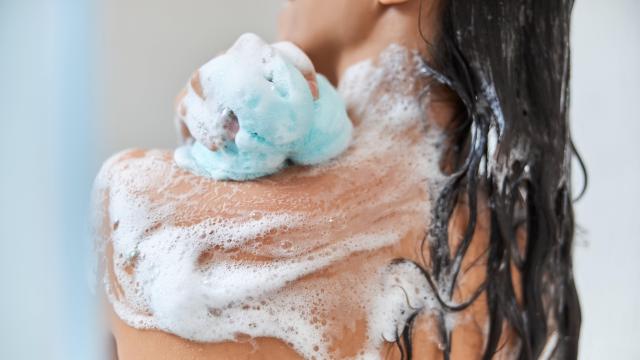Anyone who’s bathed with a loofah knows: Its lathering skills are legendary. No other soap carrier can hold a sud to the loofah’s ability to generate copious, instantaneous foam at the slightest brush across your skin. And the volume! A wash cloth could never.
But whether you prefer the soft, synthetic mesh loofahs available for $US2 ($3) at Target, or the the neutral-coloured kind made from actual gourds, unfortunately, they’re kinda nasty. They need to be replaced often — probably more often that you think.
What’s growing in your loofah?
While loofahs may start as pristine beacons of hygiene, over time, they become breeding grounds for bacteria. As the loofah spreads soap around your body, it’s performing another primary function: exfoliation. Its fibrous nature does a bang-up job scrubbing dead skin cells off your body, which is good. But that dead skin gets trapped in the loofah’s fibre matrix, then hangs out in the moist, humid environment of your shower, never getting dry — which is bad.
As board-certified dermatologist Dr. Michele Green told the Huffington Post, when a loofah doesn’t dry properly, bacteria — which like to eat organic matter — grow. And the next time you use it, “The loofah is spreading yesterday’s dirt (and bacteria) back on your body.”
According to a study published in the Journal of Clinical Microbiology, “Loofah sponges can serve as a reservoir and a vehicle for the transmission of potentially pathogenic (bacterial) species to the human skin.” It adds, “Bacterial overgrowth…literally takes place overnight.” One of those potentially pathogenic bacteria is staphylococcus, which can enter via small nicks or scabs in your skin, causing a staph infection. For this reason, it’s not recommended to use one right after shaving, or if you have any open cuts.
How to care for your loofah
While this all sounds quite ominous, if you’re not ready to ditch your loofah, there are ways you can use them more hygienically. Manufacturers, and many online sources, recommend removing your loofah from the shower to dry near an open window. However, the authors of the Journal of Clinical Microbiology study note that this process does little to reduce the numbers of bacteria present; you’d need to dry it for more than two weeks to see a significant reduction.
Instead, they recommend disinfecting it “with hypochlorite (10%) at regular intervals.” New York-based dermatologist Dr. Sejal Shah seconded this recommendation when she told WomensHealthMag.com that loofahs should be soaked in a diluted bleach solution for five minutes once a week. (Or, as the Cleveland Clinic writes, it’s one of the many unexpected items that can be cleaned in your dishwasher.)
When to replace your loofah
“Replace it frequently — every 3 to 4 weeks for the natural kind and every 2 months for a plastic pouf,” Shah says, and sooner if you notice any mould or a mildewy smell. Or, switch to a washcloth.

Leave a Reply
You must be logged in to post a comment.